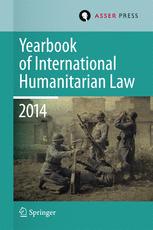Yearbook of International Humanitarian Law Volume 17 2014 1st Edition by Terry Gill, Robin Geiß, Heike Krieger, Tim McCormack, Christophe Paulussen, Jessica Dorsey 9462650896 9789462650893
$50.00 Original price was: $50.00.$35.00Current price is: $35.00.
Yearbook of International Humanitarian Law Volume 17 2014 1st Edition by Terry D. Gill, Robin Geiß, Heike Krieger, Tim McCormack, Christophe Paulussen, Jessica Dorsey – Ebook PDF Instant Download/Delivery: 9462650896, 978-9462650893
Full dowload Yearbook of International Humanitarian Law Volume 17 2014 1st Edition after payment

Product details:
ISBN 10: 9462650896
ISBN 13: 978-9462650893
Author: Terry D. Gill, Robin Geiß, Heike Krieger, Tim McCormack, Christophe Paulussen, Jessica Dorsey
This volume commemorates the centenary of the First World War (1914-2014) and aims to capture 100 years of warfare evolution. Among the main issues addressed are the changing nature of means and methods of warfare, the law of weaponry, and challenges to humanitarian assistance and protection of the civilian population affected by armed conflict. Specific topics include the legal regime governing nuclear weapons, the prohibition of chemical weapons and arms control, the evolution of naval warfare, asymmetric conflicts, the law of occupation and cultural property. A comprehensive Year in Review also describes the most important events and legal developments that took place in 2014.
The Yearbook of International Humanitarian Law is the world’s only annual publication devoted to the study of the laws governing armed conflict. It provides a truly international forum for high-quality, peer-reviewed academic articles focusing on this crucial branch of international law. Distinguished by contemporary relevance, the Yearbook of International Humanitarian Law bridges the gap between theory and practice and serves as a useful reference tool for scholars, practitioners, military personnel, civil servants, diplomats, human rights workers and students.
Yearbook of International Humanitarian Law Volume 17 2014 1st Table of contents:
Part I: The Evolution of Warfare
- The Evolution in the Legal Protection of Victims of Armed Conflict
- Abstract
- 1.1 The Emergence of Legal Protection of Victims of Armed Conflict
- 1.2 Who Is a Victim of Conflict?
- 1.3 International Humanitarian Law (IHL) and the ICRC
- 1.4 The Changing Nature of Conflict
- 1.5 Developments in Means and Methods of Warfare
- 1.6 The Way Forward
- One Hundred Years of Chemical Warfare and Disarmament: Then and Now
- Abstract
- Warfare 1914–2014: The Most Violent Century in Human History
- Abstract
Part II: The Law of Weaponry 1914–2014
- The Prohibition to Use Chemical Weapons
- Abstract
- 4.1 The Use of Chemical Weapons
- 4.2 The Prohibition of the Use of Chemical Weapons
- 4.2.1 Early Limitations upon the Use of Chemical Weapons
- 4.2.2 The 1899/1907 Hague Regulations
- 4.2.3 The 1925 Geneva Protocol
- 4.2.4 The 1993 Chemical Weapons Convention (CWC)
- 4.2.4.1 Situations Covered
- 4.2.4.2 Substances Covered
- 4.2.4.3 The CWC and Reservations to the Geneva Protocol
- 4.3 Linking the Prohibition of Use to Disarmament
- 4.4 Ensuring Accountability: Rome and Kampala
- 4.4.1 The Obligation Under the CWC to Adopt Penal Legislation
- 4.4.2 Accountability Before the International Criminal Court
- 4.4.3 Substances Covered by the Rome Statute’s Provisions
- 4.4.4 Situations Covered
- 4.5 Beyond Regime-Building: Maintaining Regime Integrity
- References
- The Evolution of Legal Approaches to Controlling Nuclear and Radiological Weapons and Combating the Threat
- Abstract
- 5.1 Introduction
- 5.2 The Evolution of Legal Rules Under the International Law of Arms Control
- 5.3 Devising an International Legal Framework to Control Atomic Energy
- 5.3.1 Overcoming “Narrow Sovereignty”: The International Atomic Energy Agency
- 5.3.2 From Non-Proliferation to Physical Protection
- 5.3.3 Other Radioactive Materials: Little Battlefield Utility, High Terrorist Attractiveness
- 5.3.4 Elaboration of a Nuclear Terrorism Convention
- 5.3.5 The Collective Security Approach: Nuclear Terrorism and the UN Security Council
- 5.4 Conclusion
- References
Part III: The Methods of Warfare 1914–2014
- The Development of the Law of Naval Warfare from the Nineteenth to the Twenty-First Century
- Abstract
- 6.1 Introduction
- 6.2 Exercise of Belligerent Rights Exclusively by Warships
- 6.2.1 Surface Warships and Converted Merchant Vessels
- 6.2.2 Submarines
- 6.2.3 Continuing Validity of the Traditional Approach
- 6.3 Protected Vessels and Persons
- 6.3.1 Hague Conventions VI and XI
- 6.3.2 Hospital Ships
- 6.3.2.1 Means of Communication
- 6.3.2.2 Arming of Hospital Ships
- 6.3.3 Protected Persons
- 6.3.3.1 Categories of Protected Persons
- 6.3.3.2 General Obligation to Rescue Survivors
- 6.3.3.3 Obligations of Hospital Ships
- 6.4 Lawful Targets
- 6.4.1 Enemy Warships and Auxiliaries
- 6.4.2 Merchant Vessels
- 6.4.3 Submarine Communications Cables
- 6.5 Methods and Means of Warfare
- 6.5.1 Mines and Torpedoes
- 6.5.2 Naval Blockade
- 6.5.3 Zones
- 6.5.4 Naval Bombardment
- 6.6 Concluding Remarks
- References
- From Inter-state and Symmetric to Intra-state and Asymmetric: Changing Methods of Warfare and the Law
- Abstract
- 7.1 Introduction
- 7.2 Armed Conflict and International Law at the Start of the First World War
- 7.3 The Second World War and the Law of International and Non-international Armed Conflicts
- 7.4 The Post-Second World War Rise of Non-international Armed Conflicts and Wars of National Liberation
- 7.5 The Predominance of Asymmetric Warfare in the Post-Protocols Era—From the End of the Cold War
- 7.6 New Laws for ‘New Wars’? Responding to the Challenge of Asymmetric Conflict
- 7.7 Conclusion
- References
Part IV: Challenges to Humanitarian Assistance and Protection
- Humanitarian Activities Carried Out Across Borders in Times of Armed Conflict in the Light of State Sovereignty
- Abstract
- 8.1 Introduction
- 8.2 Sovereignty of States
- 8.3 International Humanitarian Law
- 8.3.1 International Armed Conflict (General)
- 8.3.1.1 Conditions Attached to Entities and Persons Carrying Out Humanitarian Activities
- 8.3.1.2 Conditions Attached to Humanitarian Activities for Specific Categories of Persons
- 8.3.2 International Armed Conflict (Occupation)
- 8.3.3 Non-international Armed Conflict
- 8.4 Legal Consequences of Unlawfully Preventing Humanitarian Activities
- 8.5 Binding Decisions of the Security Council
- 8.6 Conclusions
- References
- Legal Challenges in the Provision of Humanitarian Assistance: The Case of Non-international Armed Conflicts
- Abstract
- 9.1 Introduction
- 9.1.1 Boundaries of the Framework for the Provision of Humanitarian Assistance
- 9.1.2 Typology of Non-international Armed Conflicts and Humanitarian Assistance
- 9.1.3 The Lex Specialis Doctrine and the Provision of Humanitarian Assistance
- 9.2 The Current Legal Framework for the Provision of Humanitarian Assistance in a Non-international Armed Conflict
- 9.2.1 Rights and Duties in the Provision of Humanitarian Assistance Under International Humanitarian Law
- 9.2.2 Rights and Duties in the Provision of Humanitarian Assistance Under Human Rights Law
- 9.3 Enforcement Challenges in the Provision of Humanitarian Assistance
- 9.3.1 Access for the Provision of Humanitarian Assistance
- 9.3.2 Security Council Action, Inaction and Potential Solutions for the Provision of Assistance
- 9.4 Conclusion
- References
Part V: Other Fields of Law
- A Century of the Law of Occupation
- Abstract
- 10.1 Introduction
- 10.2 The Law of Occupation as Originally Conceived
- 10.3 Development of the Law of Occupation
- 10.3.1 What Constitutes Occupation?
- 10.3.2 The Legitimate Scope of Intervention by the Occupant in the Administration of the Territory
- 10.4 Relations Between the Law of Occupation and Other Legal Regimes
- 10.4.1 Legal Regimes Applicable in Occupied Territory
- 10.4.1.1 Ius Ad Bellum
- 10.4.1.2 Self-determination
- 10.4.1.3 International Human Rights Law (IHRL)
- 10.4.2 Occupation as a Normative Phenomenon
- 10.4.1 Legal Regimes Applicable in Occupied Territory
- 10.5 Conclusion
- References
- Casualties of Armed Conflict: Protecting Cultural Property
- Abstract
- 11.1 Introduction
- 11.2 The Convention for the Protection of Cultural Property in the Event of Armed Conflict
- 11.2.1 Definition of Cultural Property
- 11.2.2 Obligations of the Parties in Peacetime
- 11.2.3 Obligations of the Parties in Armed Conflict
- 11.2.4 Special Protection
- 11.2.5 The Distinctive Emblem
- 11.2.6 Sanctions
- 11.2.7 Application of the Convention to Non-international Armed Conflicts
- 11.3 The Protocol for the Protection of Cultural Property in the Event of Armed Conflict
- 11.4 The Second Protocol to The Hague Convention of 1954 for the Protection of Cultural Property
- 11.4.1 Imperative Military Necessity
- 11.4.2 Precautions to Be Taken in an Attack
- 11.4.3 Enhanced Protection
- 11.4.4 Criminal Responsibility and Jurisdiction
- 11.5 Conclusion
- References
Part VI: Other Articles
- Year in Review 2014
- Abstract
- 12.1 Situations and Phenomena (e.g., Afghanistan, Israel/Palestine, Syria, IS, etc.)
- 12.2 Tribunals and Courts (e.g., International Criminal Court, EULEX Kosovo, etc.)
- 12.3 Arms Control and Disarmament (e.g., Conventional Weapons, Chemical Weapons)
- 12.4 Miscellaneous (e.g., Torture, Children and Armed Conflict, UN Reports)
- Military Advantage: A Matter of “Value”, Strategy, and Tactics
- Abstract
- 13.1 Introduction
- 13.2 Military Advantage and the Targeting Framework
- 13.3 Military Advantage and the “Value” of Targets
- 13.4 The Courts, Military Advantage, and Proportionality
- 13.5 Military Advantage and How Wars Are Fought
- 13.6 Conclusions
People also search for Yearbook of International Humanitarian Law Volume 17 2014 1st:
african yearbook of international humanitarian law
yearbook of international humanitarian law
isil year book of international humanitarian and refugee law
international yearbook
yearbook of international organizations pdf
Tags:
Terry Gill,Robin Geiß,Heike Krieger,Tim McCormack,Christophe Paulussen,Jessica Dorsey,Yearbook,International,Humanitarian Law,Volume 17 2014 1st


